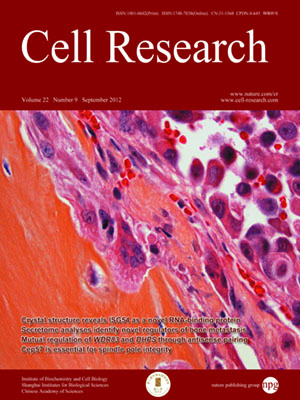
Advanced Search
Submit Manuscript
Advanced Search
Submit Manuscript
Volume 22, No 9, Sep 2012
ISSN: 1001-0602
EISSN: 1748-7838 2018
impact factor 17.848*
(Clarivate Analytics, 2019)
Volume 22 Issue 9, September 2012: 1328-1338
Zhenlin Yang1,*, Huanhuan Liang1,*, Qian Zhou2,*, Ying Li2, Haiwei Chen3, Wen Ye2, Danying Chen3, Joy Fleming1, Hongbing Shu2 and Yingfang Liu1
1State Key Laboratory of Biomacromolecules, Institute of Biophysics, Chinese Academy of Sciences, 15 Datun Road, Chaoyang District, Beijing 100101, China
2College of Life Sciences, Wuhan University, Luojia Hill, Wuhan, Hubei 430072, China
3School of Life Sciences, Peking University, 5 Yi He Yuan Road, Haidian, Beijing 100871, China
Correspondence: Yingfang Liu,(liuy@ibp.ac.cn)
Interferon-stimulated gene 56 (ISG56) family members play important roles in blocking viral replication and regulating cellular functions, however, their underlying molecular mechanisms are largely unclear. Here, we present the crystal structure of ISG54, an ISG56 family protein with a novel RNA-binding structure. The structure shows that ISG54 monomers have 9 tetratricopeptide repeat-like motifs and associate to form domain-swapped dimers. The C-terminal part folds into a super-helical structure and has an extensively positively-charged nucleotide-binding channel on its inner surface. EMSA results show that ISG54 binds specifically to some RNAs, such as adenylate uridylate (AU)-rich RNAs, with or without 5' triphosphorylation. Mutagenesis and functional studies show that this RNA-binding ability is important to its antiviral activity. Our results suggest a new mechanism underlying the antiviral activity of this interferon-inducible gene 56 family member.
Cell Research (2012) 22:1328-1338. doi:10.1038/cr.2012.111; published online 24 July 2012